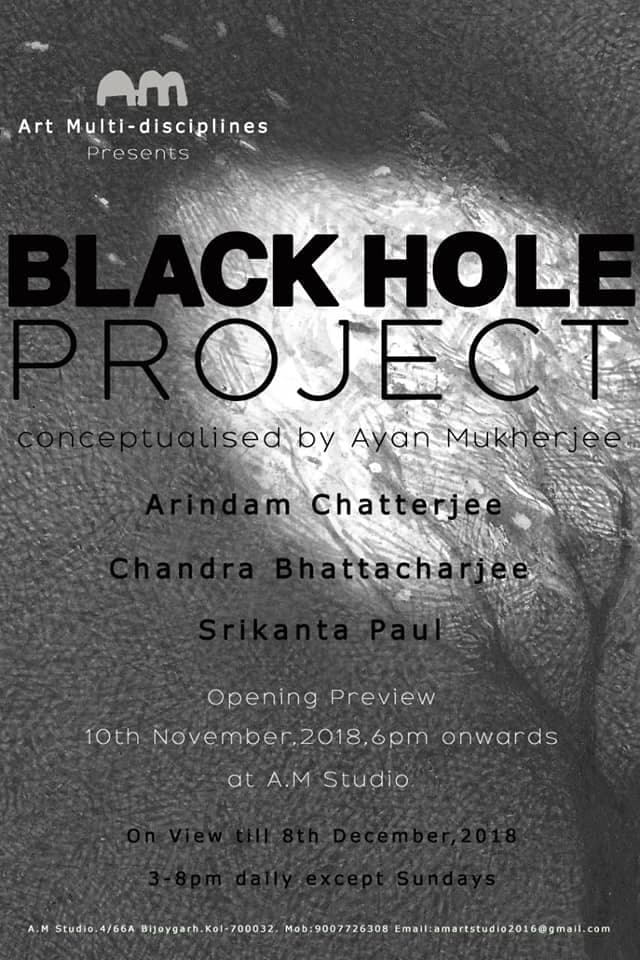Curatorial Space
- 8th June – 30th June 2022
Your name I want and war to live,
And fight the Rose to grant the disease.
Adventure to follow, advert to feel,
All in vague, satire of disbelieve…
Do we know that history may not persist??
Cross my faith to steal again,
Run the aggression and enigma
We love the Rose requisite for us
Juxtapose life towards an organic fail.
Exotic rose riots the mind
The greatness to buy and lose it off
Create a belief of dysfunctional thoughts
The abnormal deeds, the find of toil.

- 16th May 2022
সময়টা ছিল নির্ভীক রঙের।
সকাল গড়িয়ে রাত হতে দেখতাম প্রতিনিয়ত। টিউব কলের জলে তেষ্টা মিটতে দেখেছি, ফিলামেন্টর আলে আলাপ পোয়াতো রোদ্দুরের সঙ্গে জানলার খড়খড়ির ফাঁক দিয়ে উঁকি মরে।
নিরিবিলি দুপুর ঘুমিয়ে পড়লে গলি ভরা কচিকাঁচাদের গলা আহ্বান জানাতো ল্যাম্পপোস্টের হলুদ টিম টিমে আলোকে। আমি ছিলাম সেদিন, দেখেছি সবটা।
দেখতো আমার সাথে আমার বন্ধু গুলোও, বহু বছর পথ হেঁটেছি যে আমরা হাতে হাত দিয়ে।
হেঁটেছি আর গিলেছি এই শহরের ছবিগুলোর পাল্টে যাওয়াকে। নির্ভেজাল হার মেনেছে জটিলতার কাছে,
মানবিকতায় ভরপুর যত্ন ক্রমাগত আঘাত পেয়েছে লোভ চালিত যান্ত্রিক ক্রীতদাসদের হাতে।
হ্যাঁরে, তোরা হাঁফাস না? ধ্বংস দিয়ে মাখা ভাত খেতে ভালোবাসিস বুঝি?
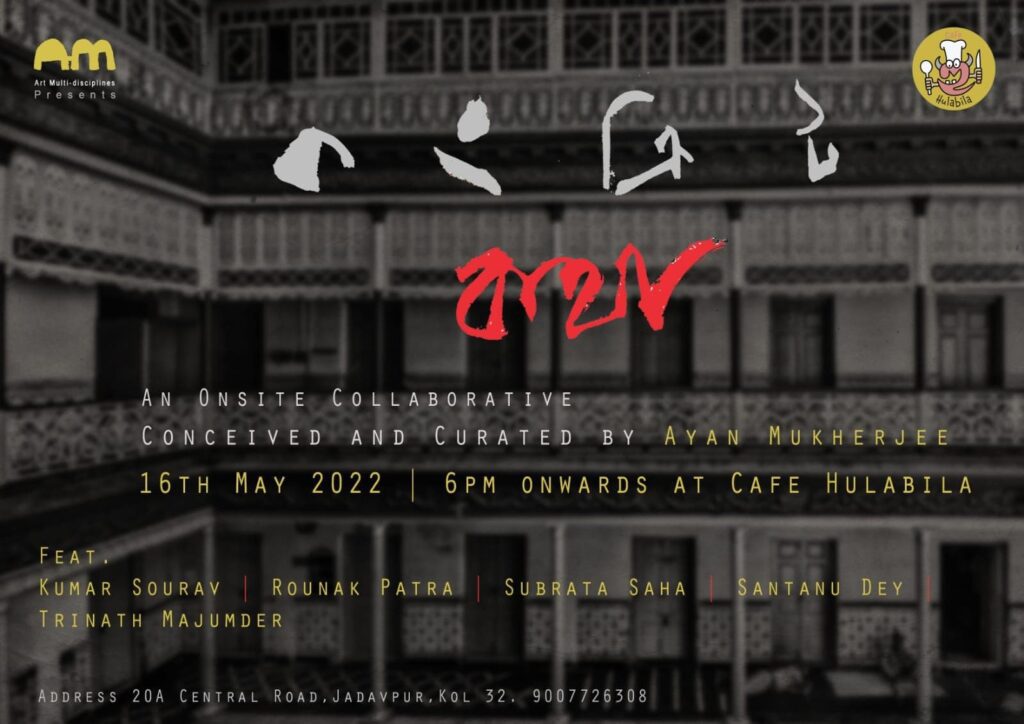
- 1st April – 15th May 2022
Dark Side of the Moon, the way I had conceived and conceptualised it, features a collection of images and the artistic voices of six different contemporary artists from Kolkata, which comprehensively discusses the philosophical, physical, and socio-political mandates of our existence that can lead us towards insanity and ultimately an unfulfilled life. The images and works try to interconnect and coherently exist to showcase the shades of today’s detrimental and hollow times leading us towards madness, intolerance, and violence. They dig deep into today’s dystopia, facilitating them to be a mirror for society, which brings forth the dark realities and sometimes acts as the root cause of this insane time and our self-centric ways of living, which advocate unfulfillment.
A reality check would suggest that there is no dark side to the moon, but while conceiving the narrative of this exhibition, this phrase turned out to be an ideal metaphor for absolute darkness. The darkness that prevails intensively can destroy all of the positive emotions of human beings and humanity as a whole. In effect, the darkness represents insanity. In reality, the light portrayed by the moon is really an illusion; it’s rather fake, as we know the moon reflects the light of the sun. In turn, this mock light of the moon turns out to be an allegory to the times our civilization advertises and the various deceptive and outlandish dimensions and perspectives of our decision-making, along with the barbaric choices we make by merely riding the tide of times and trends. The landscape of our reality, which can jolly well be termed a well-to-do hoax, harmonises and paves the way towards wretched souls, crime scenes, prejudice-driven fanaticism, abandoned relationships, intimate betrayals, and so on.

- 22nd Feb – 11th March 2022
‘যখন দেখি ওরা কাজ করে গ্রামে বন্দরে,
শুধুই ফসল ফলায়, ঘাম ঝড়ায় মাঠে প্রান্তরে
তখন ভালো লাগে না, লাগে না কোন কিছুই’
–মহীনের ঘোড়াগুলি (Mohiner Ghoraguli)
In our day-to-day interactions and exchanges, we often use the sound or word “EEYE” in place of something that we have forgotten.
In the light of this exhibition, for whom has the word “Eeye” been used?
Who are they?
Do they belong to that marginalized breed of human flesh and blood that does not leave a mark of their existence on the billboards of the society? Nameless and casteless, this ignored or cornered class has always been kept under our reigns, barred from societal acceptance. However, they have always played a vital role in organising the dire necessities of our daily lives. These hardworking beings with their silent footsteps have been creating the foundation on which we exist for ages now.
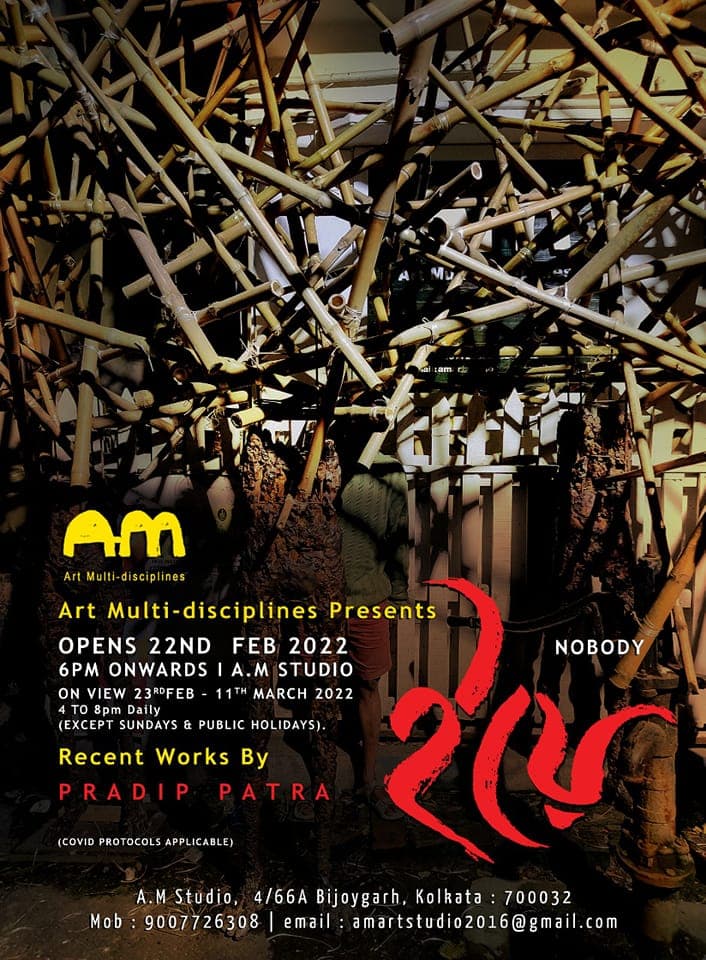
- 26th March – 17th April 2021
Chutzpah Monologue Hello? Hello??? Mic tests 1, 2, and 3 Hello…?? Awaz aa rahi hai aap laog ko??
‘Where have all the flowers gone?
Long time ago.
Oh, when will you ever learn?
Oh, when will you ever learn?
It is genuinely annoying and disturbing for me to consider and agree that the times in which we live are obligatory and distorted. People live with a deceptive state of mind and custom-made attitudes and attire. When things go out of our control, we tend to fix things by opting for the effortless option, i.e., submission. Rather, we would have loved to live with panache and conviction by telling things the way they should be told and by creating a space for harsh but true expressions along with appropriate execution.
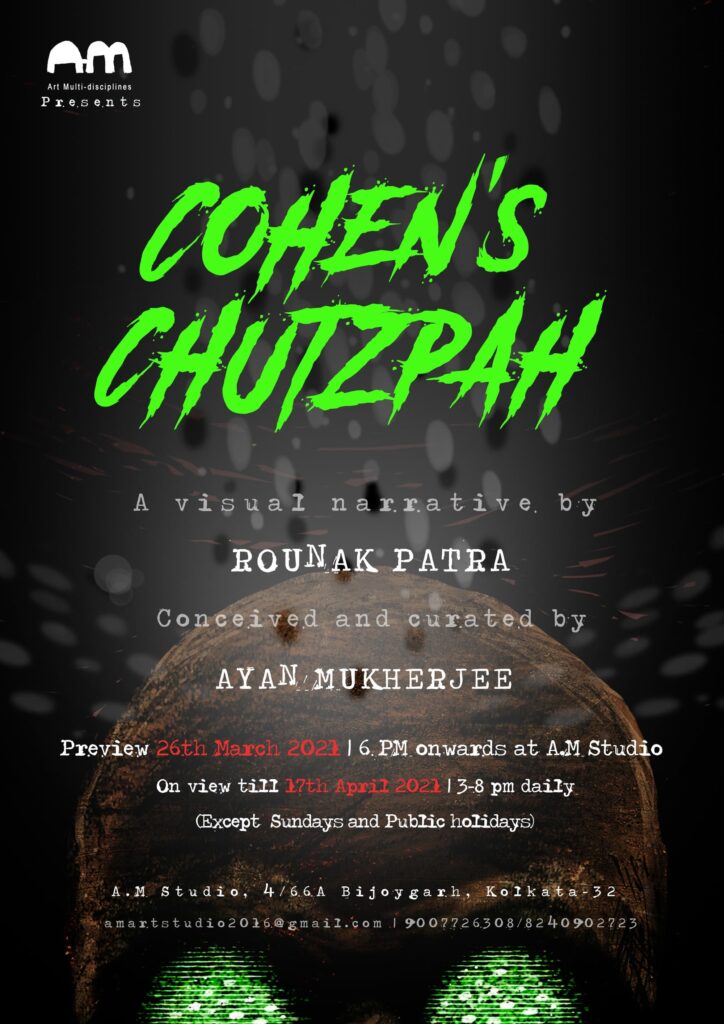
- 15th June 2020
‘Visual Dialogues on the Current Pandemic’
Conceived and Curated by Ayan Mukherjee.
These are bewildering times that our civilization is attending to and undergoing. We, the people, have a job in hand in adapting ourselves to this grave pandemic, shielding one another, thus trying to protect society from this deadly virus and ensuring the durability of our existence. In order to defend ourselves, we have been introduced to various ‘protective gears’ that are steadily becoming a part of our journey through life. These elements, speculatively, are helping us to stay alive and breathe, giving us prospects of being safe and secured from the paradox we call COVID-19.
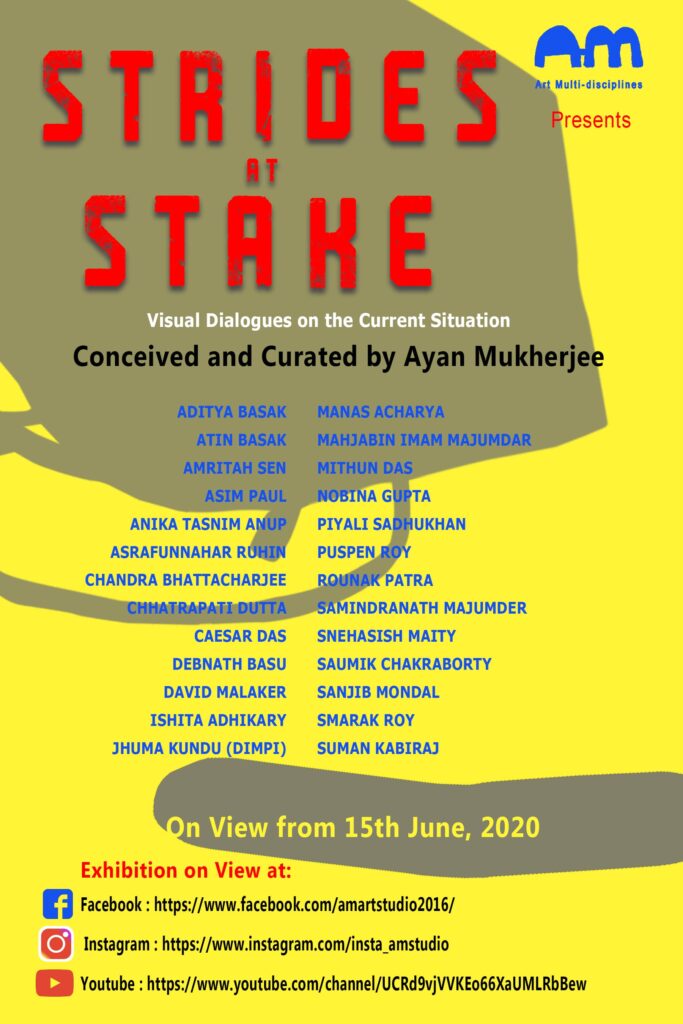
- 9th Nov – 7th Dec 2019
It’s about organising a future by annihilating the unrealized practicality of the existing reality. It’s about making merry and creating history, overlooking a world walking towards dissolution. A world filled with innovative ideas and thoughts waiting to stretch its arms towards perfection fall flat every time we search for kindness and wisdom in it. Thus carelessly proving it to be eloquently imperfect. A Part / Apart, the exhibition tries its best to talk about and question this suppressed reality of which we are all proud and euphoric.
A lost world filled with nostalgia, gone by times loaded with memories, visuals that had always been cerebral, unutteredaching’s, and a heart filled with reminiscence—that’s what I relate to when I see those bold horizontal strokes of charcoal and pastels running through the images of crows and swans, making them look meagre and grievously inconsequential in the drawings on paper (mediums being dry pastel, charcoal, ink, and graphite) by Atin Basak. They are numb, yet they tend to express themselves profoundly, somehow symbolising the materiality of the present very perceptibly.
We human beings are apotheosis, gaining the sovereignty of being the greatest living creature on this planet with our inventions, creations, and fructifications, keeping technology as our perennial partner and savior in many ways. We have touched the Moon, yet on a separate aspect, we tend to invalidate the fact that just like we are citizens of this planet we call Earth, and we avidly call it our own, the same way these cramped and tender creatures like sparrows, crows, and even pigeons, who are literally struggling for their existence, are also an elemental part of the Earth family. We graduate from our existence, overlooking the fact that we are touching extinction.
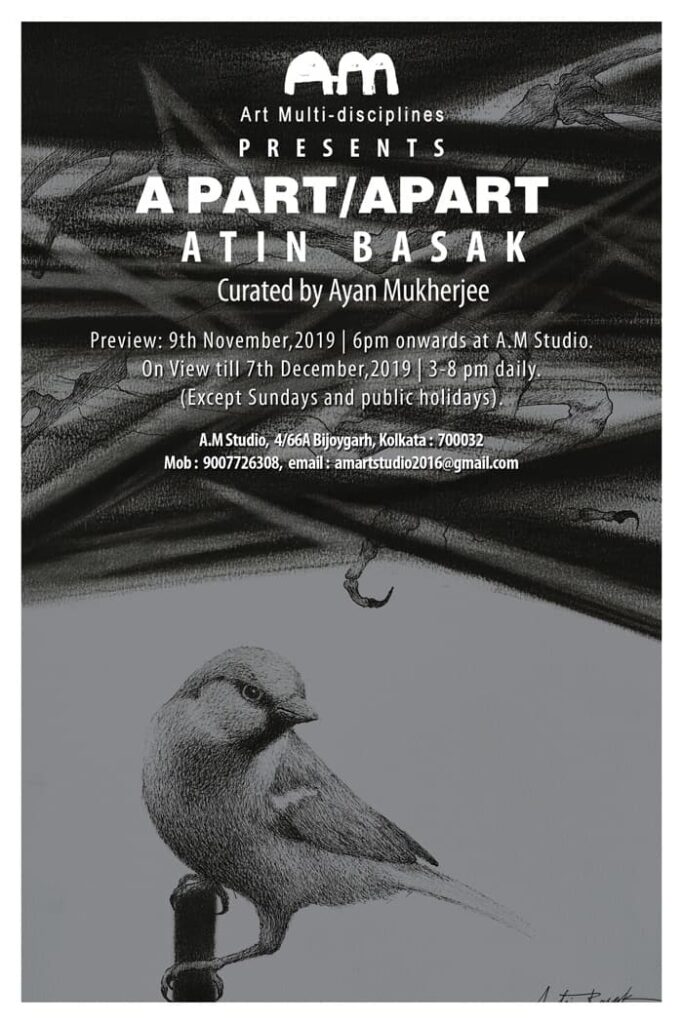
- 9th Aug – 20th Aug 2019
For me, ‘mute ‘painting’ poses a counterargument to the claim or concept that a painting is an ‘expression’; it expresses something.
Rather, for me, such an expression is a strategic political construct that suppresses the whole process of rejection, elimination, and muting those elements that, in the capacity of being inseparable and intricate parts of the process itself of such construction, could challenge the “meaning” that such a painting aims to achieve for the construct (painting) itself.
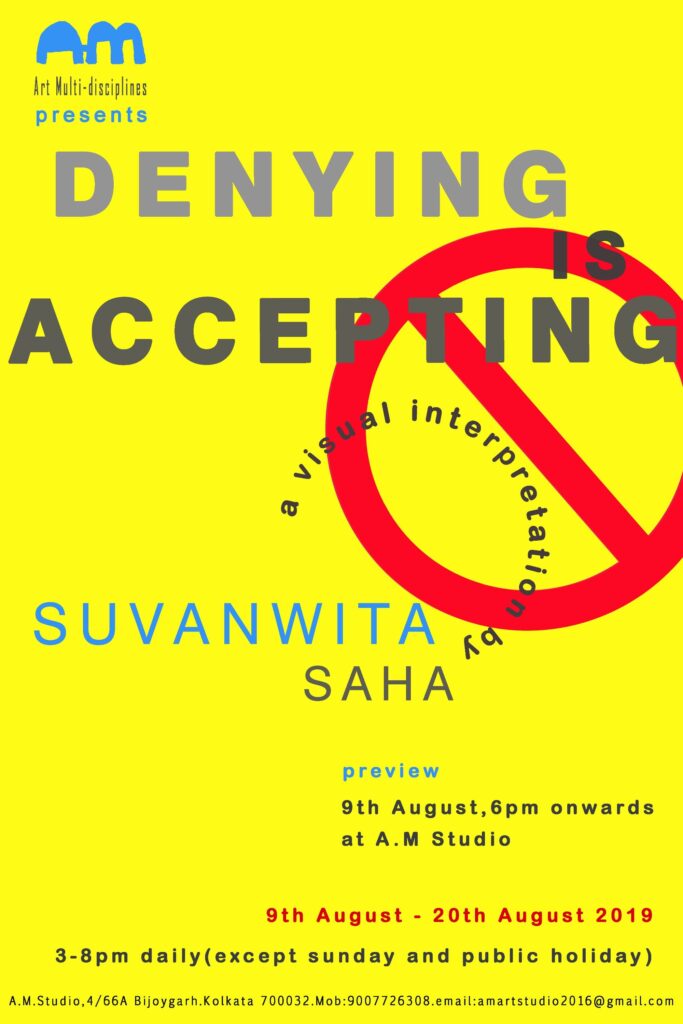
- 20th Sep – 30th Aug 2019
Saumik Chakraborty, born on July 13, 1975, is a ‘self-taught’ art practitioner and an acclaimed stage craft designer. He has been associated with the theatre industry for the last 20 years, having designed over 150 productions on stage.
My first viewing of his art works took place rather informally; in fact, I would like to call it an uninitiated accident. The reason I call it so is purely because of the sudden discovery of his work, which I realised later with time. His work is, to me, pure allegory, an image of the contemporary social situation. His work appeals and narrates not only to a restricted society but on a much larger scale; the landscape stretches out to reflect the communities and their history throughout the world. His selection of colours and tones, along with the way he tackles various mediums, only recites the metaphorical hues, which he chronicles through the melancholic nature and sensitivity of his compositions. He laments, screams, and cries in anxiety and despair. He gets frustrated with the mental trauma he experiences due to the socio-political events that trigger thoughts that get reflected in his work. Saumik’s work also displays a deep feeling of re-visiting his past struggles, hopes, memories, and remembrances, which he records with utter honesty and reality, which again demonstrates the despair and pathos of the times gone by.
Saumik explores different mediums like charcoal, conte, dry pastel, ink, graphite, and acrylic, along with the usage of techniques like photocopy transfer. Most of his works come with a dominant surface (self-made), which also acts as a fantastic background, and then we see the enactment of a subtle dialogue between the background and foreground. There’s an unrealized play of megalographical images used as a ropographical study in his works.
Ayan Mukherjee
Curator
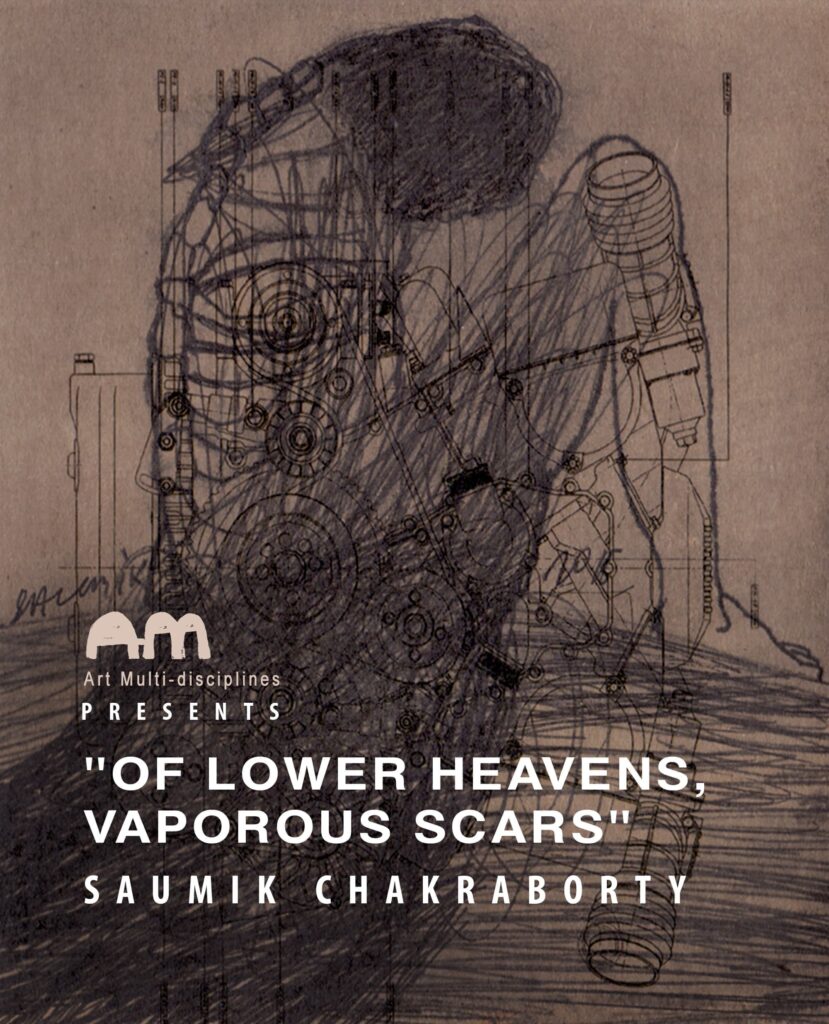
- 26th July – 4th August 2019
Sanjib Mondal’s art, a counter-practice to socio-historical criminality of the larger habitat of his belonging, manifests itself in varied forms of expression. A proficient young painter and printmaker, Sanjib, trained in Santiniketan’s Kala Bhavana, is uniquelyfocussed on making art in his own norm, within the crisis of an art practitioner’s material survival.Sanjibmakes images in the spirit of various contextual deliverances of material realities of hislife-conditions. Once as a student producing large scale experimental woodcut prints, Sanjib has gradually chosen to work with charcoal on paper, as a central medium for the fundamental design of his images, on a comparatively reduced scale. Sanjib’s use of charcoal as a medium comes from his historical consciousness of experiential belonging within the phenomenology of caste-society which is devoid of any focus of light of history. A life-world, lit by their own light of struggle for human dignity and material survival confronting endemic Brahmanic hegemony, appears in its ignored fragments in Sanjib’s images.
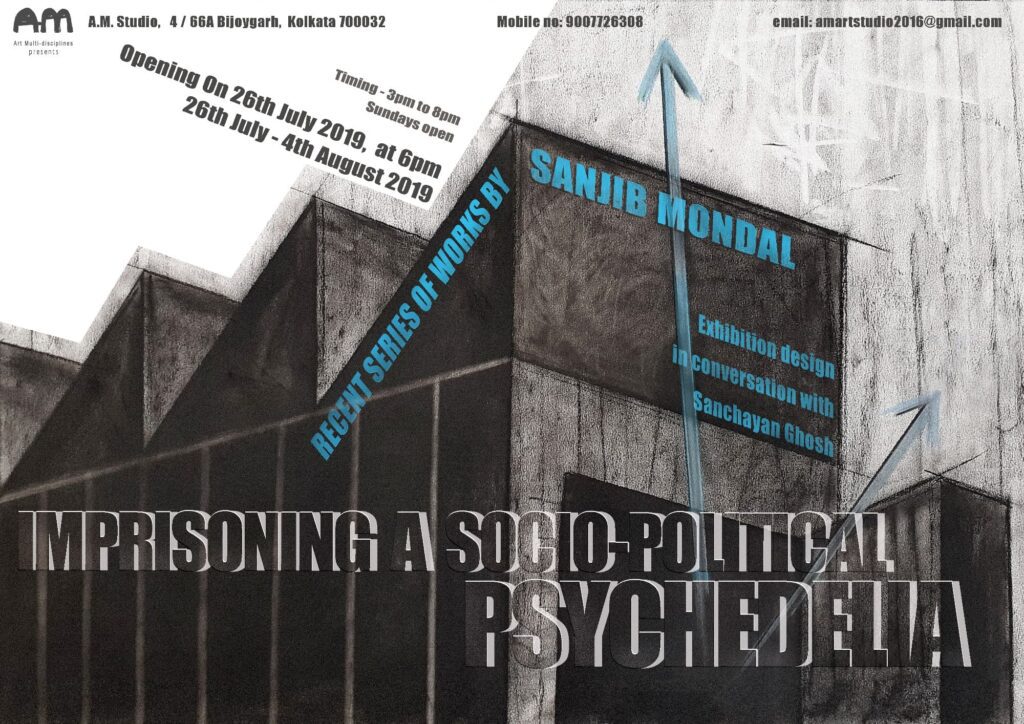
- 25th Jan – 1st March 2019
At the crest of waves in a turbulent sea one could see boats being tossed up and down and in each boat there are tiny human figures almost resembling the short-lived moths of monsoon, rising up like foams, absolutely helpless in their movements. This is the story of the present times where global migration of dispossessed people has become a daily staple for the well settled and rooted. These boats partly submerged however struggle towards a lamp post, a metaphor of good hope, a sculptural stand in for a welcoming terra firma. But the precariousness is palpable for none including the artist/creator knows whether those hapless creatures in the boats would ever reach the destinations they always dream of.
KS Radhakrishnan, in his hall mark style uses the ascending ramp form as the metaphorical oceanic surface without its undulating waves. The flatness of glistening bronze tiles virtually creates an ensemble of waves and the half boats represent their rise and fall along the ebb and flow of the tumultuous waves. An artist who believes in the ultimate transcendence of human beings or their possibilities to do so, he has always brought the ramp structure to represent such sublimation. He often refers to the liminal position of the human beings from where they could rise up to their final deliverance. While it has a spiritual connotation in some of his sculptures in ‘Ephemera’ it emphasizes a material, social and political fact in the most subtle, lyrical and metaphorical way possible.
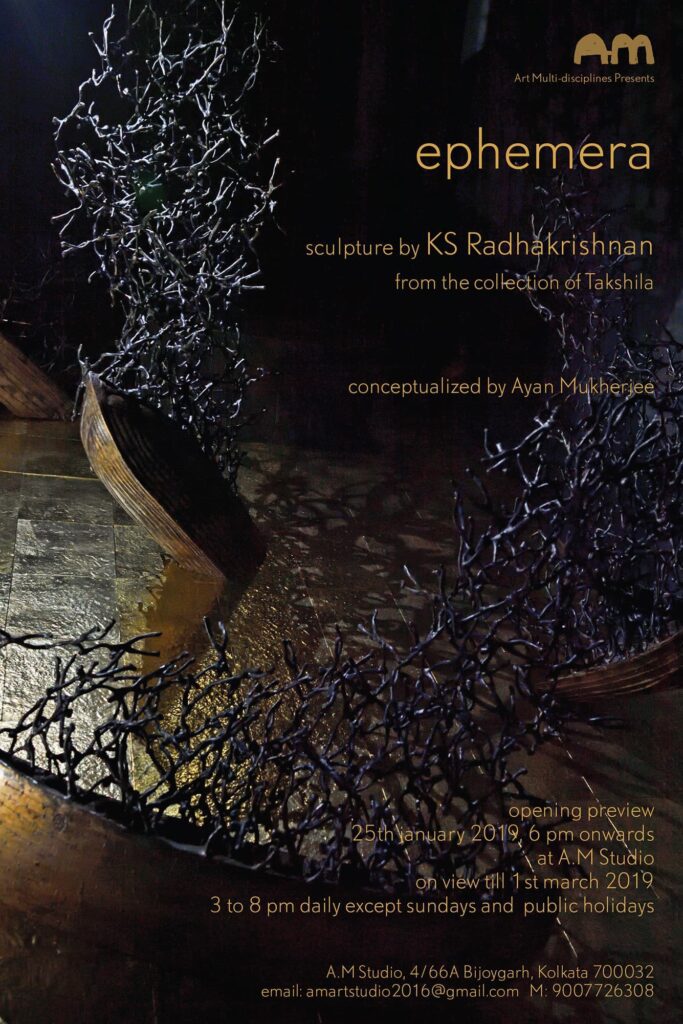
- 10th Nov – 8th Dec 2018
The amalgamation and creation of a substantial dialogue between two very important mediums of artistic interpretation, like music and visual arts, is perhaps an essential impetus behind the birth of this project. This has been my yearning for a long time. The process of materialising this urge needed a relevant reference and a practical outlook. Being a music lover and an ardent listener, I was browsing through various songs that could be my references, and after a prolonged struggle for existence, my idea attained realism. ‘BLACK HOLE SUN’, this very song, aided me big time as I conceived the idea of showcasing the mental landscape of four contrasting minds with regard to a single subject through two distinctly different mediums. Personally, I felt that the content of the song, as composed by Chris Cornell, is very significant for the current status of our contemporary society, as it very surreally talks about an optimistic plea and the craving of someone who desperately hopes for the rejuvenation and independence of mankind from the hands of various social evils, which sadly but very truly govern us today. Contemporary society coexists with these evils, and their relegation is a must for the betterment and peaceful existence of humanity and the society of which we are all part of. I believe it would be genuinely interesting for people to see the abstract reality of our society, and the exhibition would perhaps become a mirror in which we could see the practical scenario of our own existence and our civilization.
This project has been conceptualised around this song from 1990’s ‘BLACK HOLE SUN’ composed by the eminent musician Chris Cornell. The existence of black holes in space,in the centre of most galaxies, is known to us. Cornell in this song has composed a dreamscape of his own where he has portrayed ’Black Hole’ as a symbolistic element and reversed its role as a rescuer rather than a tormentor. Black holes are such a region in space through which nothing, not even light, can pass through. An optimistic request to the Black Holes to use their gravitational power and depth to attract and absorb all social, personal, and other evils that have an authoritative existence in our society towards them and wipe them out of the world can be felt very vividly in this song.
